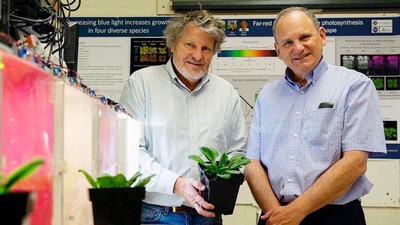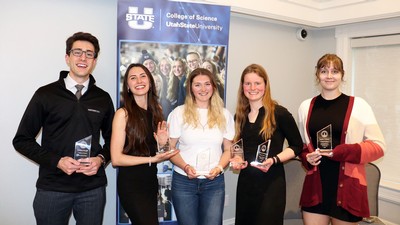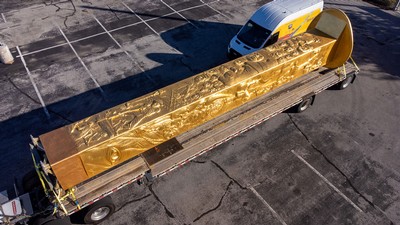Making Poplars Popular
Stands of hybrid poplar and cottonwood trees seem a bit out of place growing in neat rows, their branches reaching 20-plus feet above the soil, on research farms otherwise covered with grasses, small grains and assorted vegetables. Rapid growth rate is one reason Robert Newhall, USU Extension research associate, is experimenting with this particular species of tree. But the most important work the trees do isn't high overhead, it's in the roots where they rapidly take up nutrients like nitrogen and phosphorous supplied by pig manure and commercial fertilizer.
In addition to proving themselves capable of utilizing excess nutrients from the soil that might otherwise build up and threaten water quality, the trees provide growers with a marketable crop, create windbreaks, green-screens, stir the air to potentially limit downwind odor problems and hold soil in place.
Newhall began experiments with the trees in 1997, with support from Circle Four Farms, a large pork production facility in Beaver & Iron counties. Faced with the sort of ongoing waste management problems animal producers encounter, multiplied by thousands of pigs, the company needed data on how effective the trees might be. What Newhall has found is encouraging, and suggests that poplars could be used effectively to treat municipal and animal waste in most places in Utah.
The trees at the Utah Agricultural Experiment Station (UAES) Greenville Farm typically receive 300 pounds of nitrogen per acre and 150 pounds of phosphorous per acre, considered the standard in the agroforestry industry. But Newhall has applied more than three times that amount of nitrogen and the trees continued to perform well, without any nutrients leaching below the irrigation zone.
"I wanted to test what would happen with very high nitrogen levels and I really expected burnt leaves and dead trees," Newhall says. "Instead, they just got bigger and taller."
Agroforestry is well suited to many parts of Utah and would be a good fit with existing farming and ranching operations as well as useful for communities looking for new ways to manage municipal waste, Newhall says. Good targets for agroforestry include highly erodible, flood-prone, economically marginal and environmentally sensitive lands where the goal is not to restore a natural ecosystem, but to improve sustainability and the health of the ecosystem.
Newhall says effective agroforestry practices consider combinations of trees, crops and/or animals as a single unit. They manipulate the biological and physical interactions of those components and enhance production of more than one product at a time.
"In the case of the poplars, you can have a usable wood crop in five-to-eight years," Newhall says. "It is clean wood, though it doesn't have the heat energy of oak, but it is very benign and useful for things like pallets and crates. With 15 years’ growth you have trees large enough to be used as veneer logs."
Another nice habit of poplars is that they resprout after cutting. One objective of Newhall's experiment is to determine how many times the trees will grow back after being harvested.
"I expect there will be a lot of interest in how these trees perform," he says. "They would be very useful in a riparian corridor planted 150 feet on both sides of a stream, mixed with willows (the subject of another of his experiments along the Sevier River at the UAES Panguitch Farm)."
The poplars are proving quite robust, although they have had a few problems. Newhall lost several trees at the UAES Evans Farm in Nibley, Utah, when erratic spring temperatures in 2002 caused one variety to leaf out and freeze repeatedly, eventually killing many of them. Pests are also present—as they are in many native poplar stands —but even without any pest management practices, the trees continue to thrive.
Newhall assures potential growers that they need not have any special silvaculture skills to successfully grow poplars. The sticks and bare root material he planted in 1999 didn't appear destined to become a small forest.
"I'm an agronomist," Newhall told participants at last summer's Greenville Farm field day. "If I can grow these, anyone can. We started with some bare root material and a lot of eight-inch cuttings of one-year-old wood. They were just a bunch of sticks we planted and hoped we had the right end up and the right end in the ground. Look at them now. We're growing a crop of trees."
Contact: Robert Newhall (435) 797-2183; bobn@ext.usu.edu
Story by Lynnette Harris
Reprinted from “Utah Science,” a publication of the Utah Agricultural Experiment Station at Utah State University
Comments and questions regarding this article may be directed to the contact person listed on this page.









